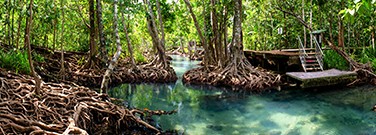Rising Seas Threaten Mangrove Forests
By Christina Phillis
Mangrove forests are reaching their limit. These collections of trees and shrubs protect tropical and subtropical coastlines from erosion and provide food and shelter to fish and other organisms. According to a report published in Science, they can’t withstand seas rising faster than roughly 7 millimeters (about a third of an inch) per year. Currently, global sea levels are rising at an average rate of 3.4 millimeters per year, and that’s expected to increase to between 5 and 10 millimeters annually by 2100.
Shelter from the Storm
According to the National Ocean Service, there are about 80 different species of mangrove trees. They grow in low-oxygen soil and in areas with slow-moving water where sediment accumulates. A number of benefits come with these water-dwelling plants. Their dense tangle of roots slows the movement of tidal waters, which helps to reduce erosion and the destructive power of storm waves. They also provide a safe haven for fish and other sea creatures and reduce carbon dioxide levels in the atmosphere.


Acting as a carbon-sequestering engine, they draw the climate change-causing element from the atmosphere and bury it in the soil. About 8,600 to 6,000 years ago, these forests stored about 85 petagrams of carbon. At that time, it would have been enough to lower carbon levels by 5 parts per million (ppm).
A Balancing Act
Until now, the mangroves have been mostly resilient in the face of sea level rise. They hold their ground as sediment builds up against their roots, which has been observed by recording how quickly sediment accumulates as the land surface elevation near the forests rises.
Because scientists have only a decade or two of data to reference, they wanted to know how well mangroves withstand rising sea levels. They looked at the period in which mangroves first started to appear. After the most recent ice age, between 26,000 and 20,000 years ago, the world started to warm, ice sheets melted, and sea levels began rising at rates faster than 12 millimeters per year. Mangrove forests began to appear as the rise slowed to an average rate of 6.1 millimeters globally.
Scientists used previously published data on 78 organic-rich sediment cores collected from coastal sites around the world, and calculated sea level rise rates for each site using computer simulations. In a high greenhouse gas emissions scenario, sea level rise is projected to increase within the next 30 years to 6 or 7 millimeters per year. Even a mid-range emissions scenario predicts sea rise rates to exceed that threshold by the end of the century. At that point, researchers believe mangroves would not be able to keep up.
Establishing thresholds for mangrove survival is important for future coastal management. Mangroves currently protect 5.3 million people around the world from storm surges. In the future, it may be our turn to protect these life-sustaining ecosystems.
Discussion Questions
- How can we save organisms like mangrove forests from the effects of climate change? Outline the steps required to stop or reduce sea level rise.
- What will happen if we lose mangrove forests? Think of other plants and marine animals that are affected by climate change. What will happen if they become extinct?
Vocabulary
- Mangroves
- Erosion